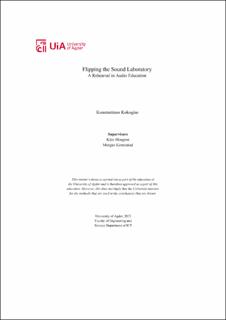| dc.description.abstract | Sound is an integral part in a multimedia production, however, obtaining audio recordings for professional purposes is a confusing process for many content creators. In the modern era of `one button´ solutions, an increasing number of people are able to produce visual material of good quality. However, in many cases sound is perceived as `just being there´, and paradoxically quality becomes noticed only when it is compromised. A characteristic of audio related work is that it is often difficult, if not impossible, to restore sound that was recorded poorly in the first place. Therefore, it is crucial to have a good understanding of the basics in order to capture an audio source in good enough quality to qualify for further processing in the editing room.
The University of Agder offers a dedicated audio course to the bachelor students of the multimedia technology and design study program on campus Grimstad. In this course, the students have the opportunity to record sound in a studio of professional standards, however, experience has shown that many feel perplexed and overwhelmed at the sight of several pieces of audio equipment which offers a variety of routing and processing possibilities. Learning and instruction in the studio has traditionally taken place through face-to-face verbal dissemination, however, poor engagement from some students during group work pointed to issues with information processing and motivation.
This thesis investigates whether a flipped learning digital resource could improve student engagement, by preparing them in advance of their participation in a physical introductory studio session. The hypothesis of the study was that students who participate in a flipped learning model end up having a better user experience in the studio than students who learn traditionally, as they feel more competent, thus confident, to engage. Two study groups evaluated their experience in the sound studio through an established tool, which was used as the basis for answering two research questions that were linked to the hypothesis. The data that was generated was correlated with other forms of data, in order to analyse the results within a sociocultural theorical perspective, in conjunction with theories that relate to memory and motivation.
The results showed a significant statistical difference in favour of flipped model students regarding their learning experience in the studio, hinting improvements in retention of information and motivational levels. The study concludes that there are positive indications that a flipped learning approach can improve engagement in an audio laboratory, however, the students´ distinct learning styles and diverse motivational orientations should be taken into account by course designers, by facilitating for enhanced flexibility and connectivity in digital resources among other things. | |
